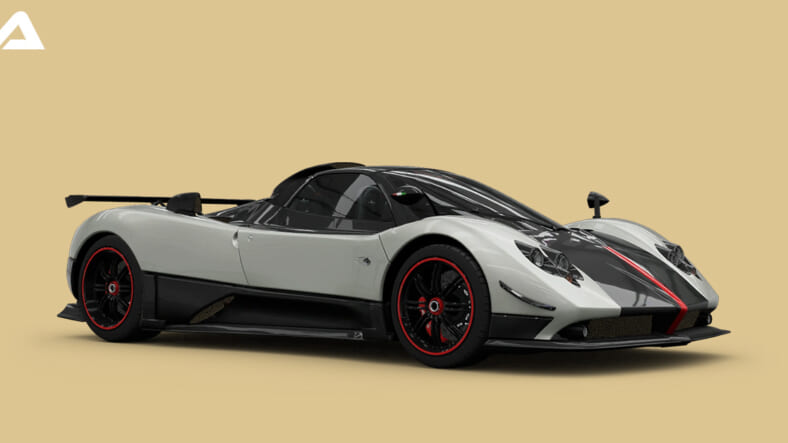A Look Back At The 2009 Pagani Zonda Cinque Roadster
It would be impossible to imagine the Pagani range without its many Zonda variants. This model was created in the […]

It would be impossible to imagine the Pagani range without its many Zonda variants.
This model was created in the Modenese Atelier in a small series of five exclusive pieces like its coupé sister, in a limited production run of just five pieces. The Roadster was indeed made out of Pagani’s new ‘wonder material’, carbo-titanium, and the hardtop Cinque was made out of the same material. Carbon fiber with titanium threads woven into it, it was first seen in the track-only Zonda R, a model that was being replaced by the C9. The C9 featured much more prominent use of titanium threads and carbon fiber. As a result, Pagani could reduce some weight from the monocoque chassis of the Zonda. This was already a bantam-weight and added unprecedented levels of stiffness to the tub itself. Due to its might, the Pagani Zonda Cinque Roadster is still regarded as one of the rarest, exotic, and exclusive vehicles ever made.
A Beautiful Yet Practical Design
A number of the weight reduction measures adopted by Pagani in the Zonda Cinque to improve driving pleasure, performance, and emissions of this car were also inculcated in the Cinque Roadster. As a result of the missing roof, the carbon-titanium chassis was redesigned to compensate for the loss.
With the roof tucked away under the front bonnet, the Cinque experience was enhanced as the air was being fed to the Mercedes-Benz AMG V12 engine via the massive intake just inches above the passengers’ ears. Accompanying it was the exhaust note generated by the Zonda Cinque Inconel and Titanium exhaust system, which was bespoke to the car.
A Lightning Fast Machine
Powered by a 7.3L AMG engine, this vehicle had 678 horsepower and a torque of 575 lb-ft. There is a ceramic coating on the titanium exhaust, traction control, and six-speed sequential transmission from Cima. Aluminum/magnesium wheels measuring 19 inches and 20 inches were forged by APP and are wrapped in Pirelli P-Zero rubber, and of course, Brembo provides the braking system with six pistons of carbon-ceramic calipers. The Zonda Cinque Roadster had a curb weight of 2668 lbs, the same as the curb weight of the hardtop. Drivers could go from 0 to 62 mph in just 3.4 seconds with this engine and reach the 124 mark mph in 6.2 seconds.
The fact that it can spin beyond 4000 RPM was downright insane. However, it was one of the reasons that made this machine so appealing to the folks. In order to make use of the performance, one has to read the road, think about the conditions, and figure out when and how to use it. The Zonda does a fairly good job of modulating the throttle, even though it has a lot of power, so doing this isn’t all that difficult.
Despite Pagani’s limited history and its small team, it’s always impressive to see so many of the fundamentals of the Zonda remain relevant even after almost a decade. For example, on the Cinque Roadster, which runs firmer suspension settings, the steering is still feel-some, the brakes have a well-defined response, and the ride is compliant, even on the Cinque, which is rather heavy-handed.
At 186 mph, the car produced 1650 lbs of downforce. Pagani also claimed to have a great 1.45 G of lateral grip, which was the highest ever seen in a road car.
The Cinque, however, was a road-going version of a previous Zonda, so it featured a single-clutch automated manual transmission with six speeds and a range of three different modes that traded shift speed for severity. Like the gearbox used in the Lexus LFA, despite its dramatic nature, it felt outdated and a little clumsy compared to some Ferraris systems of that time.
By using carbon-titanium in the construction of the Cinque, it was possible to achieve a reduction in torsional strength in the conversion of the Zonda into a Roadster than would be possible with conventional materials. While the Roadster weighed no more than the Coupe, there was no doubt that the Roadster would cope well with the bumpy roads around Modena, even though a back-to-back test was not feasible.
An Ultra-Rare And Costly Toy
Considering that the original vehicle cost less than a fifth of what Pagani is charging now, one might wonder what has led to the fluctuations in the cost. It is partly because throughout Zonda’s life, it has gradually evolved from a supercar that was already mighty to a full-blown hypercar that is simply amazing to watch
The Zonda Cinque was a limited edition, five-models-only vehicle, and the Roadster, too, only had a model run of five cars. Almost all of the hardtop Zonda R features were also found in the street-legal Zonda R.
This Zonda Cinque Roadster is yet another example of how art can be combined with engineering. Horacio Pagani’s constant efforts and his team’s dedication made the vehicle almost perfect.
